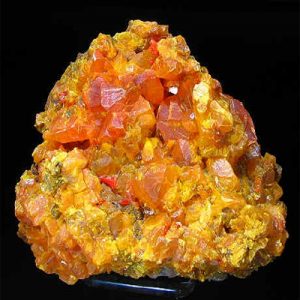Orpiment
Orpiment is a mineral that is not uncommon in small amounts, but rare as fine specimens or large crystals. Orpiment is a very interesting mineral in that it has very high RI values, very high birefringence, very strong internal reflections, very strong dispersion, very high density, very strong pleochroism and is also anisotropic. Orpiment is also dangerous since it contains about 61% Arsenic. Arsenic and its compounds are poisonous. Because of this, and the fact that Orpiment has perfect cleavage, sectile fracture and very low Moh’s hardness, it is not available as a faceted gemstone but may very rarely be found as a cabochon. Although handling is dangerous, Orpiments vivid colors do make for beautiful mineral specimens and a very rare cabochon for collectors.
Orpiment occurs in many locations worldwide but only a few produce fine specimens or large crystals. Crystals can be found at Mercury, Tooele County, Utah, USA; at the Getchell and Twin Creeks mines, Humboldt County, and the White Caps Mine, Manhattan, Nye County, Nevada, USA; fine crystals from the Zarshuran gold deposit, north of Takab, northwestern Iran; large crystals from the Shaman mine, Hunan Province, China; and exceptional specimens from the Quiruvilca mine, La Libertad, Peru.
| Category: | Sulfide mineral |
| Chemical Formula: | As2S3 |
| Arsenic sulfide | |
| Crystallography: | Monoclinic – Prismatic |
| Crystal Habit: | Commonly in foliated columnar or fibrous aggregates, with cleavages as much as 60 cm across; maybe reniform or botryoidal; also granular or powdery; rarely as prismatic crystals, to 10 cm. Twinning: On [100]. |
| Twinning: | On [100] |
| Cleavage: | [010] Perfect, [100] Imperfect; cleavage lamellae are flexible |
| Fracture: | Sectile (curved shavings) |
| Tenacity: | Brittle |
| Moh’s Hardness: | 1.5 – 2.0 |
| Density: | 3.49 – 3.56 (g/cm3) |
| Luminescence: | None |
| Radioactivity: | Not Radioactive |
| Health Warning: | CAUTION: Contains Arsenic, a poisonous element – always wash hands after handling. Avoid inhaling dust when handling or breaking. Never lick or ingest. |
| Color: | Lemon Yellow, Brownish Yellow, Orange Yellow |
| Transparency: | Transparent to Translucent |
| Luster: | Pearly Barely observable because of strong internal reflections. |
| Refractive Index: | 2.40 – 3.02 Biaxial ( – ) |
| Birefringence: | 0.620 |
| Dispersion: | Very Strong (r > v) |
| Pleochroism: | Strong: white to gray white with reddish tint (reflected light) Y=yellow, Z=greenish yellow (transmitted light) |
| Anisotropism: | Barely observable because of strong internal reflections. |


